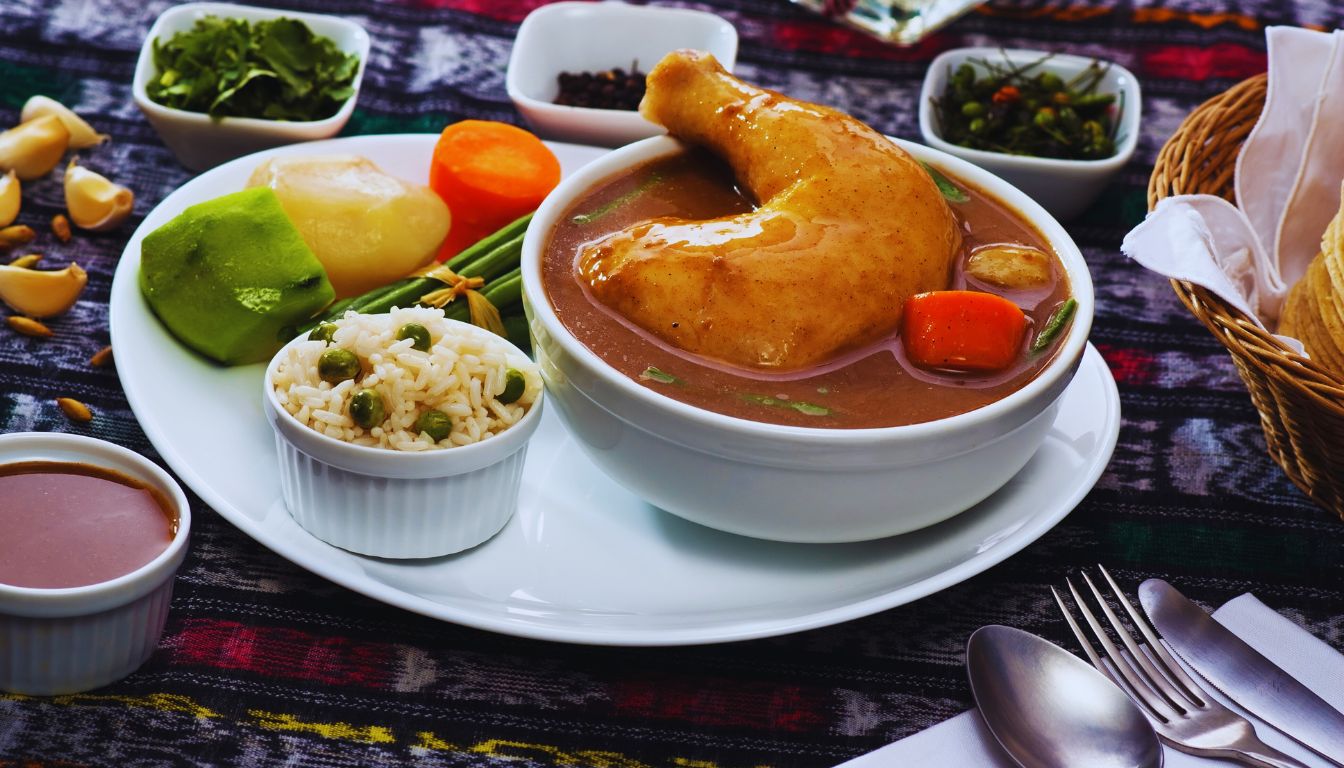Pepián, Antigua Guatemala
In the shadow of three majestic volcanoes, beneath Antigua Guatemala’s iconic colonial arches, a centuries-old culinary masterpiece continues to simmer in traditional clay pots. Pepián, Guatemala’s national dish, tells the story of two worlds colliding – ancient Maya wisdom and Spanish colonial influence. This rich, complex stew embodies the heart of Guatemalan cuisine, where every spoonful carries the weight of history and the warmth of traditional hospitality.
Table of Contents
Origins and History
Pepián’s roots stretch back to the pre-Columbian era, when Maya civilization flourished in these highlands. The dish evolved during the colonial period, becoming one of the finest examples of mestizo cuisine – the fusion of indigenous and Spanish culinary traditions. Originally served during ceremonial occasions, Pepián gained prominence in the kitchens of Antigua Guatemala, the former capital of the Spanish Kingdom of Guatemala.
The dish’s creation reflects the cultural synthesis that occurred during the 16th and 17th centuries, when:
- Maya cooking techniques merged with Spanish ingredients
- Traditional native spices combined with Old World additions
- Communal cooking methods adapted to colonial kitchen customs
Cultural Significance
In Guatemalan culture, Pepián holds a revered position as more than just a meal:
- Served at important family gatherings and celebrations
- Featured prominently in religious festivals
- Considered essential at traditional Maya ceremonies
- Passed down through generations as a symbol of cultural heritage
The dish represents:
- Family unity and tradition
- Cultural resilience
- Community celebration
- National pride
Ingredients and Preparation
The complexity of Pepián lies in its carefully balanced blend of ingredients and the methodical preparation process. Traditional ingredients include:
Base Ingredients:
- Fresh chicken or turkey
- Tomatoes
- Tomatillos
- Green onions
- Cilantro
- Sesame seeds
- Pumpkin seeds
- Various native chilies
Spices and Aromatics:
- Cinnamon
- Allspice
- Cloves
- Mexican oregano
- Garlic
- Native herbs
The preparation process involves several crucial steps:
- Seed Preparation:
- Toasting sesame and pumpkin seeds
- Grinding into a fine paste
- Sauce Development:
- Roasting vegetables and chilies
- Creating a rich spice blend
- Combining ingredients through patient simmering
- Final Assembly:
- Cooking meat separately
- Incorporating all elements
- Achieving the perfect consistency
Where to Try It
Notable Establishments
- La Fonda de la Calle Real: Renowned for traditional Pepián
- Casa de las Sopas: Specializes in traditional Guatemalan soups and stews
- Doña Maria Gordillo: Offers home-style Pepián
Neighborhood Recommendations
- Central Park Area: Historic restaurants with colonial ambiance
- San Francisco Church Area: Traditional family-run establishments
- Arch Street: Popular spots with authentic preparations
Eating Etiquette and Customs
Understanding local dining customs enhances the Pepián experience:
Serving Traditions:
- Always served hot with fresh corn tortillas
- Accompanied by rice and small garnishes
- Often enjoyed for lunch, the main meal of the day
Cultural Practices:
- Waiting for elders to begin eating
- Using tortillas to scoop up sauce
- Expressing gratitude for the meal
Seasonal Considerations
While available year-round, Pepián experiences vary by season:
Dry Season (November-April):
- Peak tourist season
- Traditional ingredients readily available
- Perfect weather for hot stews
Rainy Season (May-October):
- More intimate dining experiences
- Fresh local ingredients
- Comforting meal for cool, wet days
Modern Interpretations
While respecting tradition, some contemporary adaptations include:
- Vegetarian versions using mushrooms or vegetables
- Lighter variations with reduced cooking time
- New accompaniments while maintaining traditional sauce
Practical Information and Travel Tips
Essential information for enjoying Pepián in Antigua Guatemala:
Timing and Prices:
- Best serving times: 12:00 PM – 3:00 PM
- Average cost: 45-80 GTQ ($6-10 USD)
- Most restaurants serve daily
Location Tips:
- Many restaurants require reservations
- Central locations are easily walkable
- Some establishments close during siesta
Cultural Considerations:
- Learn basic Spanish greetings
- Respect preparation time
- Appreciate the ceremonial nature of the dish
Making Your Pepián Journey Memorable
Immerse yourself in the full cultural experience by watching your Pepián being prepared in a traditional kitchen, learning about the significance of each ingredient, and sharing the meal with locals. Remember that each bowl connects you to centuries of Maya heritage and colonial history in this UNESCO World Heritage city.













